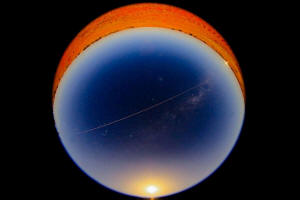Japan retrieves asteroid samples in hunt for origins of planets
 Send a link to a friend
Send a link to a friend
 [December 07, 2020]
By Stanley White and Melanie Burton [December 07, 2020]
By Stanley White and Melanie Burton
TOKYO/MELBOURNE (Reuters) - Japan has
retrieved a capsule of asteroid dust from Australia's remote outback
after a six-year mission that may help uncover more about the origins of
the planets and water, the Asian nation's space agency said on Sunday.
The mission of the Japanese spacecraft, Hayabusa2, spotlights Asia's
growing role in space exploration, with a Chinese robotic vehicle
collecting lunar samples last week for the first time since the 1970s.
A helicopter flew the capsule from the unmanned craft, containing the
first extensive samples of asteroid dust, from the landing site in
Australia's desert to a domestic research facility of the Japan
Aerospace Exploration Agency (JAXA).
"The probe landed on the asteroid twice, and the second time it created
an artificial crater and collected some debris," agency president
Hiroshi Yamakawa told a news conference.
"I hope this will shed light on how the solar system was formed and how
water was brought to Earth."

The capsule may also contain some gas, which will be extracted in
Australia, Yamakawa added.
The spacecraft, launched in 2014 from Japan's Tanegashima space centre,
journeyed for four years to the asteroid Ryugu, where it gathered a
sample and headed home in November 2019.
Spectators gathered at a theatre near the Japanese capital of Tokyo to
view the return clapped and waved banners in NHK footage, with one woman
in tears. They wore masks and kept a distance from each other as
precautions against the coronavirus.
Asteroids are believed to have formed at the dawn of the solar system,
and scientists say the sample may contain organic matter that could have
contributed to life on Earth.
"What we are really doing here is trying to sample this pristine rock
that has not been irradiated by the sun," astrophysicist Lisa
Harvey-Smith told the Australian Broadcasting Corporation.
Gases trapped in the rock samples could reveal more about conditions
prevailing about 4.6 billion years ago, she added.
[to top of second column]
|

In this handout image from Japan Aerospace Exploration Agency
(JAXA), a fireball from Hayabusa2's capsule carrying the first
extensive samples of an asteroid is seen as it reentered the earth's
atmosphere while it is observed at Coober Pedy, Australia, December
6, 2020. Japan Aerospace Exploration Agency (JAXA)/Handout via
Reuters

The retrieval of the capsule also highlights close technical
cooperation between Japan and Australia.
"Our job supporting JAXA will not be complete until we see the
sample... safely leaves Australia and returns to Japan," Megan
Clark, head of the Australian Space Agency, told the news
conference.
"And then the sample will start to tell its stories and reveal to us
some wonderful signs about how water arrived on our Earth and how we
even may have been formed, such as our organics, carbon-based
animals, humans, and plants."
Japan's craft, named for the peregrine falcon, a bird of prey,
orbited above the asteroid for a few months to map its surface
before landing. It used small explosives to blast a crater and
collected the resulting debris.
After Hayabusa2 dropped off the capsule, it changed course and
headed back into space.
The capsule lit up on re-entry into the atmosphere early on Sunday
and landed in the Woomera restricted area, about 460 km (285 miles)
north of Adelaide, the space agency said.
(Reporting by Melanie Burton; Editing by William Mallard and
Clarence Fernandez)
[© 2020 Thomson Reuters. All rights
reserved.] Copyright 2020 Reuters. All rights reserved. This material may not be published,
broadcast, rewritten or redistributed.
Thompson Reuters is solely responsible for this content.
 |